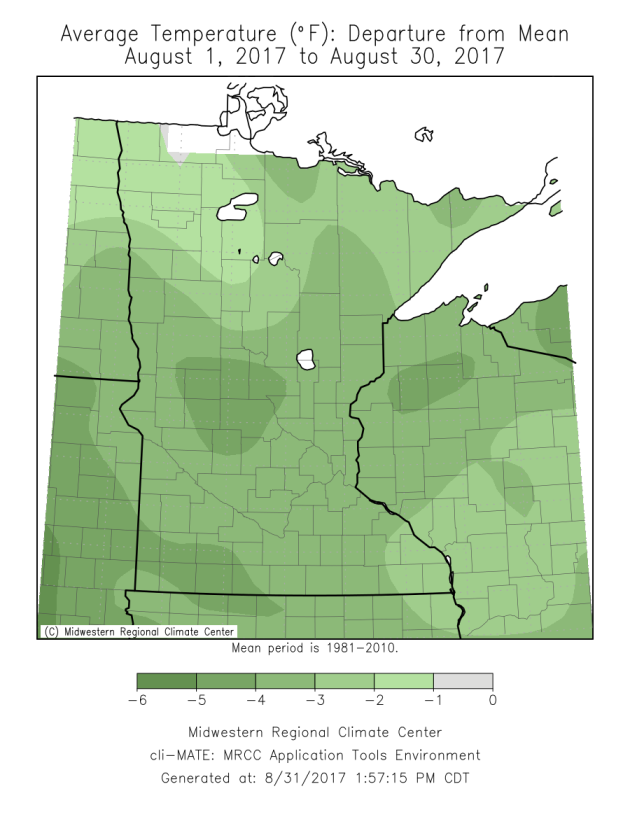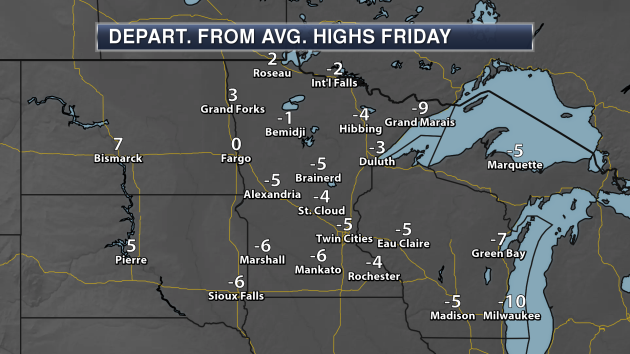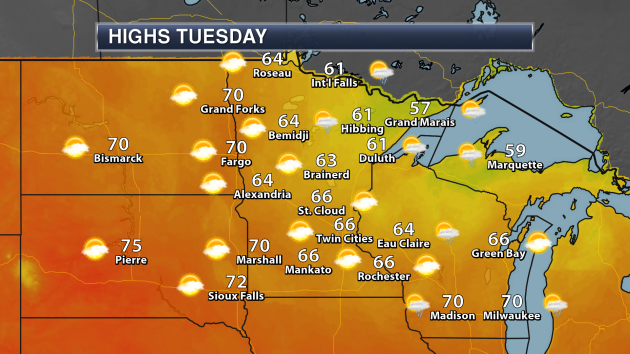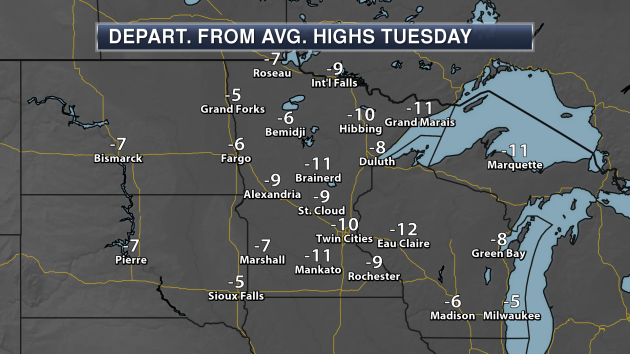Cool, Wet August Across Minnesota
August 2017 will go down as a cool than average month across the state of Minnesota. Some of the coolest weather was in the central and southwestern parts of the state, with temperatures a good 2-4 degrees below average for the month. The Twin Cities will end the month a little under two degrees below average.
It was also a wet month across a good portion of the state. Of course, we saw the
heavy rain of August 16-17 across parts of southwestern Minnesota, which helped the Redwood Falls area see a rainfall departures of 4″+ in August. The above average rain could be found from southwest to northeast Minnesota, with above rainfall departure amounts tapering off on either side. The Twin Cities will end the month about 2.50″ above average in the rainfall department. We still saw below average rainfall across parts of northwest and southeast Minnesota.
Because of that, we still have Moderate Drought across parts of northwestern Minnesota. Officially, 26.8% of the state is abnormally dry, with 17.5% of the state in Moderate Drought.
Unfortunately the latest one-month outlook from the Climate Prediction Center is calling for below average precipitation across Minnesota during the month of September, so we might not have much of an opportunity to see that drought start to fade away.
_______________________________________________
Meteorological Miracle: Nice Holiday Weather?
By Paul Douglas
As you plan your weekend activities please remember Murphy’s Third Law: “Storms, given a choice, PREFER to come on weekends and major holidays.” Of course it’s all perception. We tend to be outside on weekends; more weather-aware, more likely to gripe when the sky begins to leak.
August was about 2.3F cooler than average in the Twin Cities, but meteorological summer (June, July and August) was warmer and wetter than average. Farmers would like an extended warm period for crops to mature and fill out. That’s coming, but not until the second & third week of September, when an extended period of 80s returns.
In the meantime a shower or T-shower is possible tonight into midday Saturday. Sunday looks like the best day of the holiday weekend: 80s, sunny and dry. A much cooler front arrives Labor Day with gusty northwest winds & showers sprouting up north. By the middle of next week Canadian air engulfs the state: 60s for highs south; 50s up north with an early-season frost possible.
I’d bet a (stale) corn dog September will be warmer than average. Don’t write summer off just yet.
_______________________________________________
Extended Twin Cities Forecast
FRIDAY: Partly sunny, mild. High 73. Low 59. Chance of rain 20%. Wind SE 8-13 mph.
SATURDAY: Morning T-storm, then clearing. High 78. Low 63. Chance of rain 50%. Wind SW 7-12 mph.
SUNDAY: Sunnier, drier warmer. Best day. High 85. Low 64. Chance of rain 10%. Wind W 7-12 mph.
MONDAY: Windy & cooler. PM showers up north. High 73. Low 54. Chance of rain 30%. Wind NW 10-20 mph.
TUESDAY: More clouds than sun, brisk. High 67. Low 48. Chance of rain 20%. Wind NW 8-13 mph.
WEDNESDAY: Sunny, comfortably cool. High 69. Low 50. Chance of rain 10%. Wind W 5-10 mph.
THURSDAY: Blue sky, beautiful weather. High 75. Low 53. Chance of rain 10%. Wind SW 5-10 mph.
_______________________________________________
This Day in Weather History
September 1st
1926: Perhaps the most intense rainfall rate ever in downtown Minneapolis falls on this date. 1.02 inches of rain is recorded in six minutes, starting at 2:59pm in the afternoon according to the Minneapolis Weather Bureau. The deluge, accompanied with winds of 42 mph, causes visibility to be reduced to a few feet at times and stops all streetcar and automobile traffic. At the intersection of Second and Sixth Streets in downtown Minneapolis, rushing water tears a manhole cover off, and a geyser of water shoots 20 feet in the air. Hundreds of wooden paving blocks are uprooted and float onto neighboring lawns, much to the delight of barefooted children seen scampering among the blocks after the rain ends.
1894: The Great Hinckley Fire. Drought conditions start a massive fire that begins near Mille Lacs and spreads to the east. The firestorm destroys Hinckley and Sandstone and burns a forest area the size of the Twin Cities Metropolitan Area. Smoke from the fires brings shipping on Lake Superior to a standstill.
1807: The earliest known comprehensive Minnesota weather record begins near Pembina. The temperature at midday is 86 degrees, with a ‘strong wind until sunset.’
_______________________________________________
Average Temperatures & Precipitation for Minneapolis
Average High: 77F (Record: 97F set in 1913)
Average Low: 59F (Record: 36F set in 1974)
Average Precipitation: 0.12″ (Record: 3.29″ set in 1942)
________________________________________________
Sunrise/Sunset Times for Minneapolis
September 1st
Sunrise: 6:35 AM
Sunset: 7:49 PM
*Length Of Day: 13 hours, 14 minutes and 2 seconds
*Daylight Lost Since Yesterday: ~3 minutes
*Next Sunrise At/After 7 AM: September 22nd (7:00 AM)
*Next Sunset At/Before 7:30 PM: September 11th (7:30 PM)
_______________________________________________
Minnesota Weather Outlook
A few showers and storms will be possible during the daytime hours across western Minnesota Friday, otherwise a mix of clouds and sun are expected across the rest of the state. Highs will be in the 70s for most locations, but 60s are likely across parts of north-central and northeastern Minnesota.
Across the state highs will mainly be below average for this time of year by up to approximately 5 degrees.
We will see a warm up as we head into the weekend part of the extended Labor Day weekend, with highs reaching the low 80s by Sunday. A cold front moves through on Monday, however, dropping temperatures for the middle of next week.
Refreshing air will be in place next Tuesday for kids going back to school, with most areas of the state not making it out of the 60s for highs. A few showers will be possible across the Arrowhead.
Highs on Tuesday will be between 5 to 15 degrees below average for this time of year – certainly enough to throw open the windows (if you haven’t already) and let some free A.C. in!
We will be tracking the potential of rain into Friday night as well, but the best chance of seeing any will be across northern Minnesota. Chance only sit at about 10-20% across parts of southern Minnesota.
Overall rainfall totals are expected to be light, with the heaviest (a few tenths of an inch) expected across northern Minnesota.
After we see our slight chance of rain Friday Night… chance of rain are fairly slim through the first full week of September at the moment and even into the second week as well.
_______________________________________________
Latest On Harvey
The catastrophic floods from Harvey continue across portions of southeast Texas and southwestern Louisiana even though the rains have long since ended across the region. Areas from Houston to Beaumont have received 30-50″ of rain over the past week.
The Capital Weather Gang estimates that about 24.5 trillion gallons of water has fallen across the region due to Harvey.
Looking at rainfall totals, the top total out of Texas was Cedar Bayou at FM 1942 with almost 52″ of rain. If that were to verify, it would be the top tropical cyclone rainfall total in the state of Texas in recorded history. Parts of Louisiana have picked up just under two feet of rain.
What is left of Harvey will continue off to the northeast over the next couple days, eventually dissipating over the Ohio Valley. It will still bring the threat of heavy rain (which could lead to flash flooding) as well as gusty winds.
Rainfall totals through Saturday morning from northern Mississippi to western Kentucky are expected to be in the 3-6″ range, with heavier totals of up to 10″ possible. This could lead to flash flooding across these regions.
Of course, with heavy rain falling across parts of Texas and Louisiana, there was a major increase in soil moisture.
More from the NASA Earth Observatory: “
The map above depicts soil conditions around south Texas on August 27 compared to values observed on August 19. Colors on the map represent the amount of surface soil moisture, with the darkest colors representing soil that is saturated or nearly so. The size of each hexagon represents how much the level of soil moisture changed from the days before Harvey to the middle of the event (the most recent date for which we have data). Note that data are sparse in Houston itself, as much of that area is covered by impervious surfaces (roads, buildings, and infrastructure).“
A project called U-Flood is showing what local streets have been flooded due to Harvey.
More from c|net: “
The project, by consultants at the environmental firm Marine Weather and Climate and the tech company Tailwind Labs, is an interactive map of flooding in Houston as well as other cities like Galveston, Baton Rouge and New Orleans. It relies on the community to update the map, and so far has received more than 1,500 reports. Currently, it’s counting 991 roads inundated in Houston as a result of Hurricane Harvey.” (Image: The pink lines indicate flooded streets. U-Flood)
Repairs From Apple & Dell Delayed Due To Harvey
Are you waiting on a repair from Apple or Dell? You might be waiting a while, as both companies have repair facilities in Houston.
More from Gizmodo: “
As Texas recovers from the battering winds and record-setting rainfall of Hurricane Harvey, Apple and Dell customers elsewhere in the US are learning the storm may have some unforeseen consequences. “I got a call from an Apple employee at the Genius Bar saying that all of their laptop repairs go through Houston. I was told that it would probably take several weeks or even months to get the laptop back,” a tipster wrote to Gizmodo last night. The tipster added, “I also had a similar conversation with Dell about delays in getting a monitor repaired.”“
_______________________________________________
National Weather Outlook
Friday Highs
While Harvey continues to push through the Tennessee and Ohio Valleys, temperatures will be warming across parts of the west on Friday, with numerous record highs expected in California (more on that in a moment). It’ll feel more like the end of September versus the beginning of it, though, from the upper Midwest to the Northeast. Highs will not make it out of the 50s across parts of New England Friday.
Highs will be cooler than average across portions of the eastern United States, with the greatest departures found in the Northeast and Ohio Valley which will be on the order of 10-20 degrees. It’ll be warm out west, however, with highs that are a good 10-20 degrees above average.
Some of the heat out west could set record highs as we head through Friday, including in Redding and Sacramento. If Sacramento hits 110 on Friday, it would be their warmest September temperature on record.
The heaviest rain through the Labor Day weekend will be across parts of the Tennessee and Ohio Valleys, as well as in the Mid-Atlantic, thanks to Harvey.
_______________________________________________























